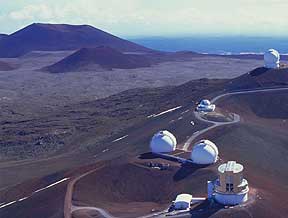Mauna Kea observatories

Mauna Kea observatories are a cluster of observatories, containing 11 major telescopes, near the summit of Mauna Kea ('White Mountain'), a dormant volcano on the island of Hawaii, the largest and southernmost of the Hawaiian Islands. The highest point in the Pacific Basin, and the highest island-mountain in the world, Mauna Kea rises 9,750 meters from the ocean floor to an altitude of 4,205 meters above sea level, which places its summit above 40% of Earth's atmosphere. Among the instruments located there are the twin 10-m telescopes of the Keck Observatory, the 8.3-meter Subaru Telescope, the 8.1-meter Gemini Telescope (North), the 3.8-meter United Kingdom Infrared Telescope, the 3.1-meter Canada-Hawaii-France Telescope, the 3-meter NASA Infra-Red Telescope Facility, the 15-meter submillimeter-wave James Clerk Maxwell Telescope, 10.4-meter Caltech Submillimeter Observatory. The Submillimeter Array is currently under construction, while the westernmost antenna of the Very Long Baseline Array is situated at a lower altitude, 3 kilometers from the summit.
The atmosphere above the mountain is extremely dry, which is crucial for infrared and submillimeter observations, and cloud-free, so that the proportion of clear nights is among the highest in the world. The exceptional stability of the atmosphere above Mauna Kea permits more detailed studies than are possible elsewhere, while its distance from city lights and a strong island-wide lighting ordinance ensure an extremely dark sky. A tropical inversion cloud layer about 600 meters thick, well below the summit, isolates the upper atmosphere from the lower moist maritime air and ensures that the summit skies are pure, dry, and free from atmospheric pollutants.


